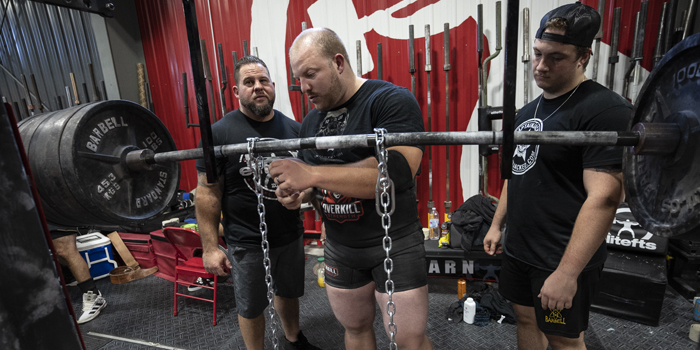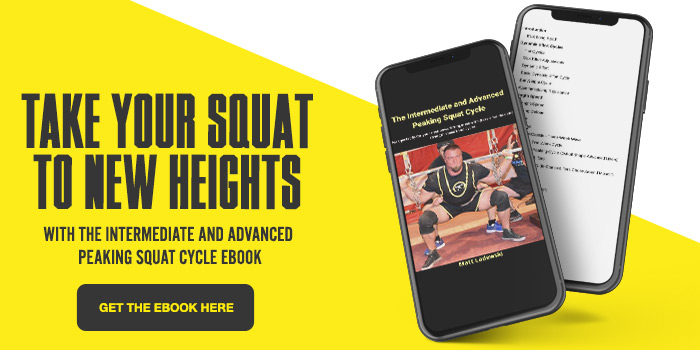
Meet prep can be a very stressful time. You are trying to get stronger and must display it in front of your peers. There are so many variables outside lifting weights that you can’t control everything. For those of you who are control freaks or just want to perform better on meet day, I have what you need.
Here are six tips from my book, The Intermediate and Advanced Lifters Peaking Squat Cycle, that will help you perform your best when it counts the most.
Don’t leave pounds on the platform due to improper planning.
Work Backward
You will want to peak on a specific date with any meet prep. Once you know how to build and choose the pieces you need in your prep, you will need to start at the end. Working backward from the meet date, you will lay out your basic training. It will also allow you to work around any pre-planned travel, holidays, or foreseen issues. It will also allow you to line up your waves and take your last deload before the long push to a new record. If planned correctly, even if you have to miss a week, you can easily make adjustments through the rest of your training to accommodate for the absence.
This plan should not contain every assistance exercise and detail. This is a view from 10,000 feet. What is the main plan for your dynamic effort and max effort days? What are the must-haves and where can you call audibles? Where will you take your heavy gear work if needed? Do you need to travel for certain workouts? Have a plan so there are as few surprises as possible.
Delayed Transformation
Working backward helps you plan for delayed transformation. These cycles will be very taxing and recovery is key. Every workout your body will try to adapt to the demands you placed on it. Those adaptations are not immediate. You want your adaptations and recovery highest on meet day. General physical preparedness, your daily life stress, and the intensity of your training will influence when you’ll perform your last big workout. Most often, this will fall 14 to 21 days out. Inside of 14 days, you may not be able to recover in time to peak properly for meet day. Remember, we’re recovering the central nervous system, along with the muscular system.
When fully recovered, you’ll feel ready to train or lift a few days out from the meet. Your body might still have aches and pains, but if you feel mentally sharp and ready to go, you have nailed it. The delayed transformation period will also give you some relief if you need to make a large weight cut, which is another beast that must be done right.
Grounding
Extreme band tension phases produce a grounding effect. Three-hundred pounds of band tension does not feel the same as three-hundred pounds of bar weight. The positioning of the bands and the way they drive the bar down to their anchored position locks you into a grounded feeling. Free weight will drift forward, back, or side-to-side, unlike bands. Toss in a box to squat on and many have a hard time transitioning their newfound strength into the meet day records. This is why free squatting without bands is recommended for the last week or two. This will allow you to work on free squatting to depth and get used to not having bands on the bar.
Train at 100%
Getting ready for the Arnold Classic, I started to have piriformis tightness. I couldn't walk right for the first thirty minutes of the day. Despite the pain, I continued to push my training forward. I was only training at 75-80% of what I needed to make progress. I couldn't do exercises like Reverse Hypers® without pain in my hip the following day. I pushed for 12 weeks and failed to break my personal record. It would have been better to take a few weeks off or work around it for a few weeks. Eight weeks at full go is better than 12 weeks with limited capacity. You must also know when to back out in favor of competing in a few months instead of losing a few years.
Bread and Butter
As you approach the meet, you will be bringing in more specific exercises. You want the exercises with the most influence or carry-over on your main lifts closest to the meet. With proper programming, you should be able to run those bread and butter (or 9's and 10's) exercises easily for the last six to eight or even twelve weeks. Every person should have two to three exercises that directly influence their main lift. If you don't have those, you need to figure them out as soon as possible. Without those exercises, you are just pissing in the wind and hoping for the best. The more variables you can control, the faster your progress.
Detour Ahead
As with everything in life, there will be detours. Even though many of your cycles may be laid out nearly the same from 10,000 feet, they will look different up close. The equipment, injuries, training age, training partners, cancellation of meets, and many other variables can change. Be prepared to make adjustments. You can't get so set in your ways that if something changes, you have to bail from the meet. Bad things can and will happen. Learning to deal with those detours is part of becoming an advanced lifter.
The same thought process applies to every meet and venue. Each will be different. Some meets will have shitty equipment. It is just a simple fact that sometimes the bars suck or are thinner, thicker, stiffer, and whippier with more or less knurling than you used in training. You will have to make the best of it. Be ready for hot or cold venues, lack of space to warm up, whites for high squats, or reds for squats at depth. You don't have to be happy about it, but don't be a prima donna. Control what you can, but be ready for a detour.
Building To Big Cycles
You can't just jump into a peaking cycle. I guess you can, but I would not recommend it. That is a sure-fire way to get hurt. Meet prep (peaking cycle) is about fine-tuning all of your work up to that point. Before your peaking cycle, you should have already brought up your GPP, builders, torso work, recovery, nutrition, and sleep. Each one of these plays a role in your success come meet day. A 20-week prep will allow for 12 weeks of training to put you in place to break a record. Each of the keys listed above must be improved over those 12 weeks. You can run a very short circa max phase, but your body must be ready to handle that stress, or your performance will be limited. Worse yet, it can result in injury.
Early in your powerlifting journey, just showing up at the meet is enough. As you continue to get stronger, you will need to refine your cycle and peaking process. To squeeze every pound out of your lifts that you worked so hard to improve, you must be at your peak on meet day.
Pick up your copy of The Intermediate and Advanced Lifters Peaking Squat Cycle to get even more information on how to push your squat to new records.
Matt Ladewski has been involved in the sport of powerlifting for over 20 years. As his pursuit of bigger numbers of his own has concluded, his attention has shifted to coaching his athletes, including a WPF and an AWPC champion. As a columnist for elitefts, Matt shares his training knowledge and experience as he writes about both his own training and the coaching of his athletes. Matt's best competition lifts include an 835-pound squat, a 550-pound bench press, and an 800-pound deadlift.










